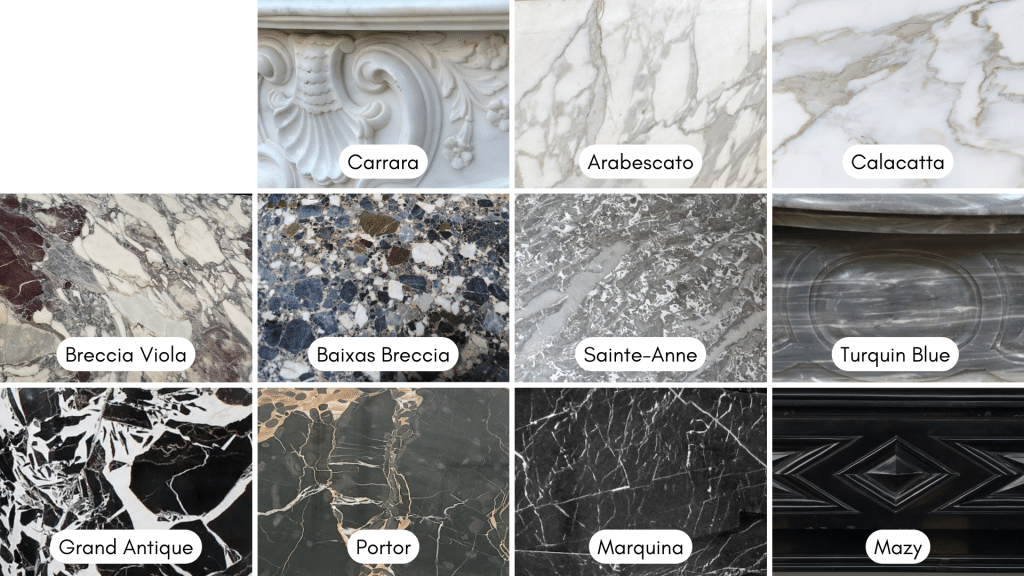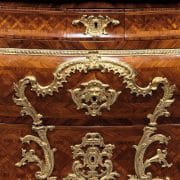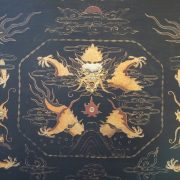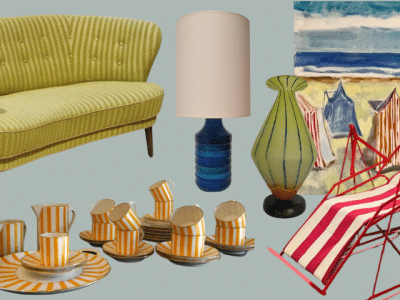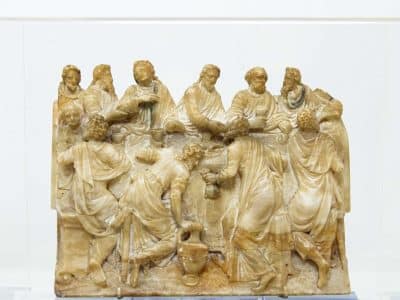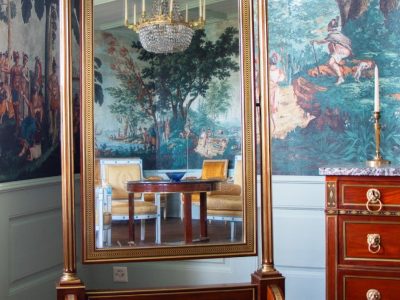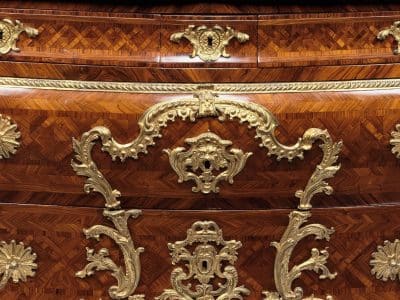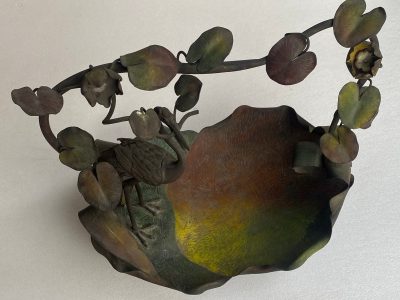Welcome to the guided tour of our virtual white, grey, and black marble gallery! You are going to discover the hues, color mixes, and patterns developed by white Carrara, arabescato, calacatta, breccia viola, Baixas breccia, and Sainte-Anne marble (the other types will be developped later). A tour illustrated by examples of marble integrated into antique and vintage furniture and decorative objects.
If you ever thought that white, grey or black marble sounded dull, you are certainly in for a surprise. There is the digital and industrial world where creating a perfect white or black is easy. Nature makes things far more interesting. It is not often that marble is strictly white or strictly black. And grey is the richest color—with far more than fifty shades…
Carrara Marble
The marble basin of Carrara spreads over the communes of Carrara and Massa in the northwest of Toscana, Italy. It is in the Apuan Alps, a misnomer for what is a region of the Apennines. There are many quarries for many types of Carrara marble, from the purest white to beige, grey and blue tonalities. Marble has been extracted from there for over 2,000 years. Over 150 quarries are active today to give an idea of how important extraction still is. Below, we delve only into the most popular types of marble from Carrara.
White Carrara, Bianco and Statuario
This marble is the most famous of all, standing out for its bright white and snow-like translucence. This is the kind jumping to everyone’s minds when we say Carrara marble.
The outstanding pedigree of Carrara marble owes a lot to celebrated statues and sculptures, Michelangelo being only one of the artists who enjoyed carving this noble material. But this article is focused on decorative arts, so let us have a tour of the objects putting Carrara’s white luster to good use.
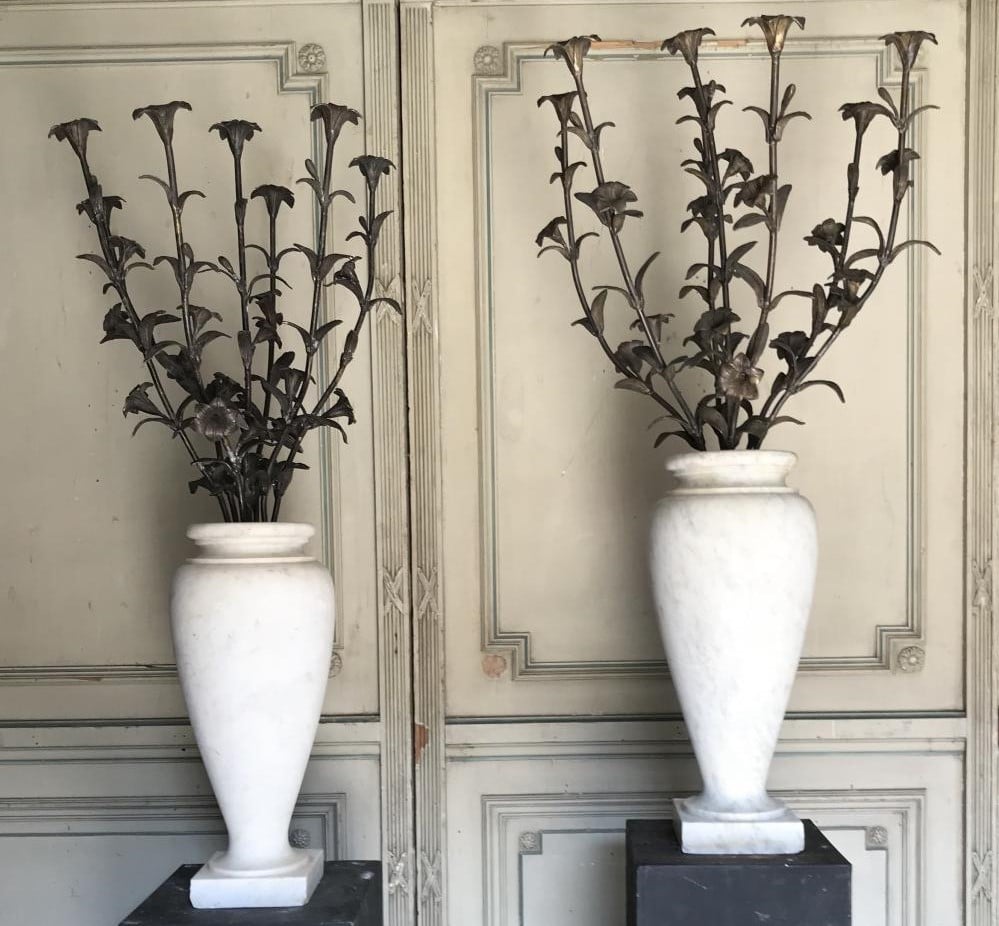
The Carrara white of these vases is enhanced by the black patina of the bronze bouquets. © Frédéric Dulyere
Large vases are good examples. A classic item in white Carrara is the Medici-style vase frequently used as a pair to ornate a garden or a terrace. They can also be of the best effect in an entrance. Originally purposed to decorate a fireplace mantel (with the Carrare marble contrasting on the colored or black mantel), some pairs of candelabra are crowned with a (gilt-)bronze bouquet in urn-shaped vases.
Among garden antiques, fountains are also commonly in white Carrara. A basin on foot with gadroons is a possible incarnation.
If you are willing to repurpose religious artefacts, many holy-water stoups in churches were in Carrara marble. Those in a shell shape are very decorative. Nowadays, depending on their size, they can be used as sinks or catchalls.

Stoup or fountain in white Carrara marble. © Dorotea Arte di Francesco Arena
Arabescato and Calacatta
The charm of arabescato or calacatta marble essentially lays in its delineated veining. Arabescato and calacatta are not always easy to differentiate. Sometimes, it takes an expert eye. Hopefully, these pointers will help you recognize them.
Arabescato tends to have darker grey veins than calacatta, of a grey that can be bordering on green or violet. It is prone to display a cloudy pattern.

These two vintage Tulip round dining tables by Saarinen are in arabescato (on the left © Alexia Say) and calacatta viola (on the right © Relics Antiquités).
Calacatta is also a mix of white and grey. The white tends to be less bright than in arabescato or white Carrara, showing a warmer ivory tone. The grey is overall less contrasted than in arabescato. It may contain gold streaks (calacatta oro) or have rather dark violet-burgundy veins (calacatta viola) or green veins (calacatta verde).
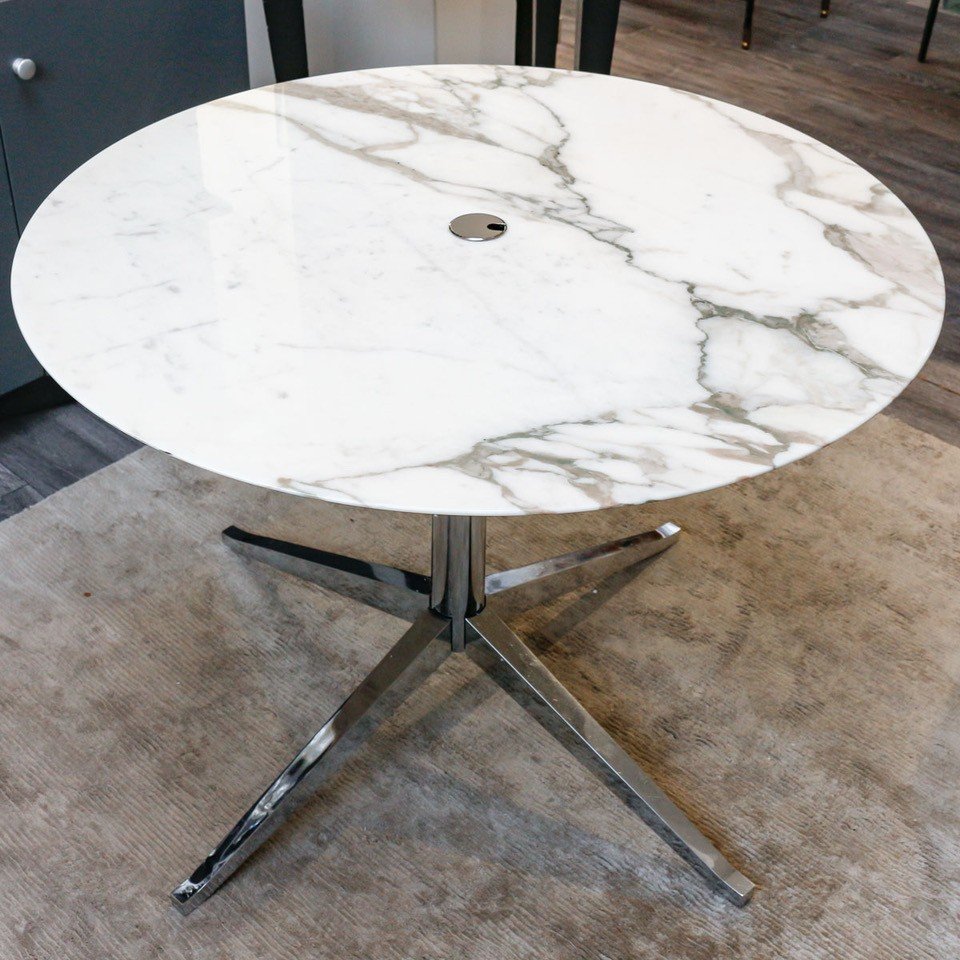
A vintage round dining table by Florence Knoll with calacatta oro verde marble top. © Alexia Say
These beautiful patterns look best when given ample space. Tables or consoles are perfect for this. The mid-1950s creations of Florence Knoll or Eero Saarinen—with the Tulip table—are iconic with either an arabescato or calacatta top (among other possibilities).
Breccia Viola
Breccia means rubble in Italian. It is a multicolor rock composed of angular marble chunks cemented together. In the case of breccia viola, the cement is violet/purple to grey and the marble fragments are white, yellow (to green) and pink-to-purple.
As you may have noticed, the range of colors is difficult to describe. This is typically when pictures are worth a thousand words. As you have both light and dark colors in the palette, depending on the proportions, you end up with significantly different results as illustrated below.

Breccia viola is very spectacular and decorative. These two columns in breccia viola give a good idea of how light or dark it may be. Left: © Cheminées Camus Fils. Right: © Antiquités Rodriguez Décoration.
It is a rare and coveted marble with a highly decorative value. It works particularly well with ormolu or gilt wood.
Could you guess where breccia viola is originally coming from? The left column gives you a better hint if you focus on the white marble fragments that look like debris of… Carrara marble. Indeed, breccia viola comes from the vicinity of Carrara, more specifically Serravezza.
Baixas Breccia
The full French name of this breccia is brèche orientale de Baixas, brèche orientale for short. It you like this lively stone, it may be useful to know it to widen your Web searches. Baixas breccia is quite contrasted with white, grey and black fragments in a cement either yellow/ocher to red, or grey. Considering the geometric patterns and color scheme, it works well in Art Deco furniture or sculptures to enhance amber or black tonalities.

Baixas breccia marble is an excellent fit for Art Deco. Whatever the proportion of white or black, the ocher golden hues are elegant. Left: © Galerie Divins Intérieurs. Right: © Guittot Antiquités.
We know for certain it has been extracted since the 13th century for architectural purposes. Baixas is a small town near Perpignan in the southwest of France, i.e. bordering the Pyrénées. One quarry is still open today for construction, but no longer with the purpose of selling marble blocks.

Art Deco spelter panther with black patina on a Baixas breccia marble. © Guittot Antiquités
Sainte-Anne Marble
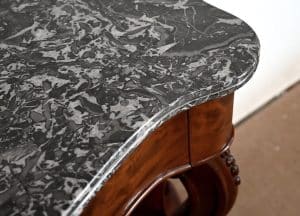
Sainte-Anne marble top of a console table in mahogany. © Antiquités Lecomte
Compared to the previous breccia, it is far easier to describe the colors of Sainte-Anne: mostly grey with more or less white. The proportion of white will tell if it is called petit, moyen or grand mélange. There is elegance and solemnity in this stone.
Genuine Sainte-Anne marble is from Belgium in the Hainaut area. The quarries were near Charleroi in Labuissière, Gerpinnes, Gougnies, or Biesme. It is no longer extracted since 1975.
This type of marble was very successful in the last part of the 18th century to cover large surfaces: walls, pavement, church altars, columns, fireplaces… It may also top furniture, especially in mahogany, walnut, maple, or satinwood. It is a favored marble for furniture of the Restauration and Louis-Philippe period (standing for the last French kings, after Napoleon I and before the 1848 Revolution). Of course, you can also find it on earlier or later pieces.

A typical tripod center table in mahogany with paw feet of the Louis-Philippe period. The Sainte-Anne marble top has a raised rim and reeded edge. © Philippe Lavirotte
~ MAIN STORY: A Guide to Marble in European Antiques ~
You May Like
White Marble | Grey Marble | Black Marble | Carrara | Arabescato | Calacatta | Breccia Viola | Sainte-Anne Marble


